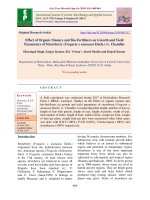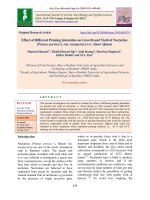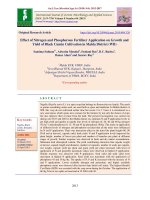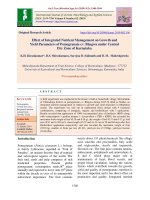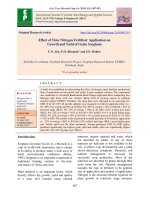Effect of nano ZnO on growth and yield of finger millet [Eleusine coracana (L.) Garten.]
Bạn đang xem bản rút gọn của tài liệu. Xem và tải ngay bản đầy đủ của tài liệu tại đây (208.77 KB, 7 trang )
Int.J.Curr.Microbiol.App.Sci (2019) 8(2): 1365-1371
International Journal of Current Microbiology and Applied Sciences
ISSN: 2319-7706 Volume 8 Number 02 (2019)
Journal homepage:
Original Research Article
/>
Effect of Nano ZnO on Growth and Yield of Finger Millet
[Eleusine coracana (L.) Garten.]
Saraswathi1*, Y. Vishwanath Sheety1, M. Dinesh Kumar2 and K.T. Gurumurthy1
1
2
Department of Soil Science and Agriculture Chemistry, College of Agriculture,
Department of Agronomy, College of Agriculture, University of Agricultural and
Horticultural Sciences, Shivamogga
*Corresponding author
ABSTRACT
Keywords
Nenotechnology,
Nanoscale,
Chelated zinc
sulphate, Zinc
oxide, Nano
fertilizer
Article Info
Accepted:
12 January 2019
Available Online:
10 February 2019
With the growing limitation in arable land and water resources, the development of
agriculture sector is only possible by increasing resources use efficiency with the
minimum damage to agro ecology through effective use of modern technologies. Among
these, nano technology has the potential to revolutionize agriculture system. An
investigation was initiated to examine the effect of nano scale zinc oxide particle on plant
growth and development. In view of the widespread cultivation of ragi in India and other
parts of the globe and view of the potential influence of zinc on its growth, this crop was
chosen as the model system. A pot culture experiment was conducted during Rabi 20162017 with the foliar application of nano scale zinc oxide particle at lower rate dose
compared to the chelated zinc sulphate recommended and we recorded higher grain yield
(9.60 g plant-1) and straw yield (15.87 g plant-1) in T7 which receive nano ZnO @ 500 ppm
ha-1 as foliar spray respectively, compared to chelated zinc sulphate. The inhibitory effect
with the higher dose nano particle concentration (nano ZnO @ 1250 ppm) reveals the need
for judicious usage of this particle in such application, this study show that the use of nano
fertilizers causes an increase in nutrient use efficiency, reduces soil toxicity associated
with over dosage and reduces the frequency of the application. Hence nanotechnology a
high potential for achieving sustainable agriculture, especially in developing countries.
Introduction
Agriculture is the backbone of most
developing countries, with more than 60% of
the population reliant on it for their
livelihood. Agricultural scientists are facing a
wide spectrum of challenges such as
stagnation in crop yields, low nutrient use
efficiency, declining soil organic matter,
multi-nutrient deficiencies, climate change,
shrinking arable land and water availability
and shortage of labor besides exodus of
people from farming. In spite of immense
constraints faced, we need to attain a
sustainable growth in agriculture at the rate of
4% to meet the food security challenges.
Therefore in the future, emphasis should be
laid on production of high quality food with
1365
Int.J.Curr.Microbiol.App.Sci (2019) 8(2): 1365-1371
the required level of nutrients and proteins,
(Pijls et al., 2009; Ghaly and alkoaik, 2010).
The issue of micronutrient deficiency is
related with food security Micronutrient
deficiencies in human being as well as crop
plants are difficult to diagnose and
consequently the problem is termed as
‘hidden hunger’ (Stein et al., 2008). This
hidden hunger may cause nearly 40%
reduction in crop productivity among them
Zinc (Zn) deficiency is most wide spread
nutritional disorder. Most of the Indian soils
are found to be Zn deficient, hence the food
crops grown in those soils contain less
amount of Zn. In order to overcome Zn
disorder, several strategies are being
employed
including
supplementation,
fortification,
diversification
and
biofortification. Among these strategies
biofortification of food crops with Zn is
considered to be cheaper and sustainable.
To address these problems, there is a need to
explore one of the frontier technologies such
as ‘Nanotechnology. It is a new emerging and
interesting field of science is currently applied
in many areas. It has great application in the
field of agriculture. Nano particles (NPs) are
commonly accepted as materials with at least
two dimensions between 1-100 nm.
“Nanotechnology is the art and science of
manipulating matter at nanoscale. Because
nano particles are spherical or faceted metal
particles typically < 100nm in size. These
nano particles are having high surface area
(30-50 m2/g), high activity, better catalytic
surface, rapid chemical reaction, rapidly
dispersible and adsorb abundant water. So
nano fertilizers may increase the efficiency of
nutrient uptake, enhance yield and nutrient
content in the edible parts and also minimize
its accumulation in the soil. In view of the
above facts the present study entitled Effect of
nano ZnO particle on growth and Yield of
Finger Millet (Eleusine coracana (L.)
Garten.)
Materials and Methods
The present investigation was carried out at
Zonal Agriculture and Horticultural Research
Station, University of Agricultural and
Horticultural Sciences (UAHS), Navile,
Shivamogga to study the effect of Nano Zinc
particle on growth and yield of finger millet
in a pot culture experiment. The details
regarding the collection of soil sample,
methodology followed in the pot culture
experiment and analytical methods employed
during the course study for soil and plant
analysis as per the standard procedure. Bulk
soil samples collected from micro watershed
in different land use system in kadur taluk of
chikkamagalur district were categorized as
low to medium with respect to native soil
fertility status zinc nutrients. Surface soil
samples to a depth of 30cm were collected for
the pot culture experimentation. The collected
samples were characterized for various
physical and chemical properties. Same
sample used for pot culture experiment to
study the growth and yield of finger millet.
The experiment was laid out in a Complete
Randomized design. With ten treatments
involving various concentrations of nano ZnO
and three replication with two sources used in
these experiment one is Zinc oxide (ZnO)
nano particle which is having particle size of
50 nm and ZnSO4.7H2O were used in the
study. ZnO nanoparticles of mean size of 50
nm diameter were used in the study. Chelated
bulk ZnSO4.7H2O was used as a reference Zn
source. Because bulk ZnO will not dissolve in
water and plants cannot absorb it, farmers are
widely using chelated ZnSO4.7H2O. The
materials were suspended directly in
deionized water and dispersed by ultrasonic
vibration (100 W, 40 KHz) for 30 min.
Magnetic bars were placed in the suspensions
for stirring before use to avoid aggregation of
the particles. The soil sample was thoroughly
mixed with FYM and filled in pots of 20 kg
capacity having hole on the corner of the
1366
Int.J.Curr.Microbiol.App.Sci (2019) 8(2): 1365-1371
bottom of the container. Nitrogen, Phosphorus
and potash were added to each pot at the rate
of 50, 40, 25 kg ha-1, respectively using urea,
SSP and MOP. Zinc was applied in the form
of ZnSO4.7H2O to treatments T3 and T5 for
soil and foliar for T4 and T5 application,
respectively. Whereas, foliar application of
nano zinc oxide was done in T6 to T10
applied at time (30 DAT and 60 DAT) as per
treatment details T1: Absolute control, T2:
RPP, T3: Soil application of ZnSO4.7H2O @
10 kg ha-1 at sowing,T4: Foliar ZnSO4.7H2O
@ 0.5 % ha-1 at 30 and 60 DAT, T5: Both soil
and Foliar application ZnSO4.7H2O @ 0.5 %
ha-1 at 30 DAS, T6: Foliar Nano ZnO @ 100
ppm ha-1, T7: Foliar Nano ZnO @ 500 ppm
ha-1, T8: Foliar Nano ZnO @ 750 ppm ha-1,
T9:Foliar Nano ZnO @ 1000 ppm ha-1,
T10:Foliar Nano ZnO @ 1250 ppm ha1
.Periodical observations (30, 60 at harvest
DAT) on growth and yield parameters.
Results and Discussion
Growth parameter
In this study, results showed that the different
forms of zinc sources they are ZnSO4.7H2O
as conventional fertilizers and nano ZnO
significantly influenced the plant growth
attributes of finger millet. Among the various
treatments, application of NPK+FYM+ Soil
and Foliar application ZnSO4.7H2O @ 0.5 %
ha-1 (T5) recorded maximum plant height of
30.47 cm and minimum plant height of 18.50
cm were observed in control treatment (T1) at
tillering stage. At harvest stage the highest
plant height was recorded in the treatment
(T7) 120.50 cm with the foliar application of
nano ZnO @ 500 ppm and control (T1)
treatment was recorded 85.00 cm in (Table 1
and Figure 1). This might be due to profound
influence of Zinc fertilizers on height of plant
as increased metabolic process in plant which
has promoted meristamatic activities causing
higher apical growth and photosynthetic area.
The results are in agreement with the finding
of (Dekhane et al, 2011). Number of leaves in
finger millet also differed significantly at all
the growth stages. However, there is an
increase in number of leaves to foliar
application of nano ZnO at harvest Treatment
receiving foliar spray of nano ZnO @ 500
ppm (T7) recorded the highest number of
leaves 42 and in control (T1) 25.00
respectively (Table 1). Whereas, higher
concentrations @ 1250 and 1000 ppm
exhibited detrimental effects on growth of
finger millet. (Prasad et al, 2012) observed
that nano ZnO promoted seed germination,
seedling vigor, early flowering and higher
chlorophyll content in leaf. They also
observed beneficial effects of NPs in
enhancing plant growth, development and
yield in peanut at lower doses, but at higher
concentrations ZnO NPs were detrimental just
as the bulk nutrients. Number of earheads of
finger millet, the finger length and test weight
were significantly high in treatment receiving
fertilizer and FYM along with nano ZnO
foliar spray @ 500 ppm, which was superior
over all other treatments. The significant
increase in test weight may be attributed to
better grain filling due to improved nutrient
supply (Table 2).
Yield parameter
The results of the study revealed that
application of nano ZnO as foliar spray has
recorded highest grain yield (9.60 gm plant-1)
and least in control without application of
fertilizers(7.00 gm plant-1) in Table 2. Nano
particles (NPs) with small size and large
surface area are expected to be the ideal
material for use as a Zn fertilizer in plants. It
is because of that when materials are
transformed to a nano scale, they change their
physical,
chemical
and
biological
characteristics as well as catalytic properties
and even more increase the chemical and
biological activities (Mazaherinia et al.,
2010).
1367
Int.J.Curr.Microbiol.App.Sci (2019) 8(2): 1365-1371
Table.1 Effect of different levels of foliar application of ZnSO4.7H2O and nano ZnO formulation at different growth stages
on growth parameters of finger millet
Treat.
No
Treatment
Number of leaves hill-
Plant height (cm)
1
Tillering
stage
T1
Absolute control
18.50
Ear
head
stage
57.00
T2
RPP (Recc NPK +FYM)
23.00
60.50
100.00
20.00
28.00
T3
NPK+FYM +Soil application ZnSO4.7H2O @ 10 kg ha-1 at
sowing
NPK+FYM+ Foliar ZnSO4.7H2O @ 0.5 % ha-1 at 30and 60
DAT
NPK+FYM+ Soil and Foliar application ZnSO4.7H2O @ 0.5 %
ha-1
NPK + FYM +Foliar Nano ZnO @ 100 ppm ha-1 at 30 and 60
DAT
NPK +FYM +Foliar Nano ZnO @ 500 ppm ha-1 30 and 60 DAT
27.00
65.42
96.00
29.00
30.00
25.00
66.00
97.43
25.00
32.00
30.47
67.00
110.00
30.00
38.00
20.60
62.55
99.00
25.00
29.00
26.00
70.00
120.50
28.00
42.00
NPK+ FYM+ Foliar Nano ZnO @ 750 ppm ha-1 at 30 and 60
DAT
NPK+ FYM + Foliar Nano ZnO @ 1000 ppm ha-1 at 30 and 60
DAT
NPK + FYM + Foliar Nano ZnO @ 1250 ppm ha-1 at 30 and 60
DAT
S.Em+
25.00
69.00
105.00
28.00
41.00
23.00
60.00
89.56
27.00
39.00
19.00
58.00
85.56
25.00
35.00
0.61
0.66
1.13
0.58
0.65
C.D @1%
2.41
2.65
4.53
2.32
2.61
CV
4.35
1.77
1.96
3.46
2.73
T4
T5
T6
T7
T8
T9
T10
1368
Harvest
stage
Tillering
stage
Harvest
stage
85.00
18.00
25.00
Int.J.Curr.Microbiol.App.Sci (2019) 8(2): 1365-1371
Table.2 Effect of different levels of foliar application of ZnSO4.7H2O and nano ZnO formulation
at different growth stages on grain and straw yield of finger millet
Treat.
No
T1
T2
T3
T4
T5
T6
T7
T8
T9
T10
Treatment
Grain yield
Straw yield
gm pot
Absolute control
RPP (Recc NPK +FYM)
Soil applicationZnSO4.7H2O @ 0.5 % at sowing ha-1
Foliar ZnSO4.7H2O @ 0.5 % ha-1 at 30and 60 DAT
Soil and Foliar application ZnSO4.7H2O @ 0.5 % ha -1
Foliar Nano ZnO @ 100 ppm ha-1 at 30 and 60 DAT
Foliar Nano ZnO @ 500 ppm ha-1 at 30 and 60 DAT
Foliar Nano ZnO @ 750 ppm ha-1 at 30 and 60 DAT
Foliar Nano ZnO @ 1000 ppm ha-1 at 30 and 60 DAT
Foliar Nano ZnO @ 1250 ppm ha-1 at 30 and 60 DAT
SEm±
C.D @1%
CV
7.00
7.60
7.85
7.84
8.40
7.35
9.60
9.30
7.60
7.40
0.34
1.36
7.78
-1
11.25
12.10
12.63
12.87
14.77
12.16
15.87
15.40
11.53
11.04
0.41
1.65
5.43
Fig.1 Plant height as influenced by different foliar application of ZnSO4.7H2O and nano ZnO
formulation at different growth stages of finger millet
T1:Absolute control
T6: Foliar Nano ZnO @ 100 ppm ha-1 at 30 and 60 DAT
T2:RPP (Recc NPK +FYM)
T7: Foliar Nano ZnO @ 500 ppm ha-1 30 and 60 DAT
T3:Soil application ZnSO4.7H2O @ 10 kg/ha at sowing
T8: Foliar Nano ZnO @ 750 ppm ha-1 at 30 and 60 DAT
T4:Foliar ZnSO4.7H2O @ 0.5 % at 30 and 60 DAT
T9 :Foliar Nano ZnO @ 1000 ppm ha-1 at 30 and 60 DAT
T5: Soil and Foliar application ZnSO4.7H2O @ 0.5 %
T10Foliar Nano ZnO @ 1250 ppm ha-1 at 30 and 60 DAT
1369
Int.J.Curr.Microbiol.App.Sci (2019) 8(2): 1365-1371
Prasad et al., (2012) studied the effect of
nanoscale zinc oxide on the germination,
growth and yield of peanut and observed
significantly more growth and yield.
Reynolds
(2002)
demonstrated
that
micronutrients in the form of NPs can be used
in crop production to increase yield.
There was a promontory effect on dry matter
production with the application of nano ZnO
with @ 500 ppm. There after inhibitory effect
was noticed. Based on the results, the highest
(15.87 gm plant-1) dry matter weight was
recorded in the treatment (T7) receiving nano
ZnO @ 500 ppm and lowest were in control
(11.25 gm plant-1). Improvement in growth
parameters like plant height, number of leaves
and leaf area per plant due to foliar
application of nano ZnO resulted in increased
dry matter accumulation (Table 2). Total
biomass or crop dry weight (CDW) is the
result of these two processes. Harvest index
(HI) is the ratio of grain yield to biological
yield, i.e., a measure of the efficiency of the
plant when accumulating assimilates in the
organs of economic significance (Moragues et
al., 2006). Significant relationships between
yield and biomass at anthesis or during grain
filling have been reported in bread wheat
(Turner, 1997) and durum wheat (Ramdani,
2004).
In conclusion, application of nanotechnology
in agriculture is still in its budding stage.
However, it has the potential to revolutionize
agricultural systems particularly where the
issues on fertilizer applications are concerned.
Nano fertilizer application promoted the
growth, development, and has the potential to
improve crop production and plant nutrition
with greater effectiveness and agronomic
efficiency compared to traditional sources of
fertilizers. A new class of nano ZnO
fertilizers to enhance the growth and yield of
finger millet through pot culture test in an
inert growing medium showed that
application of nono ZnO by foliar application
with lower dose as zinc sources promoted
higher finger millet growth rate than regular
ZnSO4.7H2O fertilizer treatment. This
research indicated that nano ZnO in
enhancing grain yield and biomass
production. The outcome of this research
would be beneficial for other studies
involving the application of nanotechnology
in the field of agriculture.
References
Ghaly, A. E. and Alkoaik, F. N., 2010,
Extraction of protein from common
plant leaves for use as human food.
American J. App Sci. 7: 331-342.
Mazaherinia, S., Astaraei, A. R., Fotovat, A.
and Monshi, A., 2010, Nano iron oxide
particles efficiency on Fe, Mn, Zn and
Cu concentrations in wheat plant. Word
App Sci J. 7(1):36-40.
Moragues, M., Garci, A., Del Moral, L. F.,
Moralejo, M. and Royo, C. 2006, Yield
formation strategies of durum wheat
landraces with distinct pattern of
dispersal within the Mediterranean
basin II. Biomass production and
allocation. Field Crops Res., 95:182 –
193.
Pijls, L., Ashwell, M. and Lambert, J., 2009,
EURRECA-A network of excellence to
align
European
micronutrient
recommendations. Food Chemistry.
113:748-753.
Prasad, T. N. V. K. V., Sudhakar, P.,
Sreenivasulu,
Y.,
Latha,
P.,
Munaswamy, V., Raja, K., Reddy,
Sreeprasad, T. S., Sajanlal, P.R.,
Pradeep, T., 2012, Effect of nanoscale
zinc oxide particles on the germination,
growth and yield of peanut. J Plant
Nutri., 35: 905- 927.
Ramdani, A., 2004, Impact of Spanish and
Italian breeding activities on durum
wheat yield and associated morpho-
1370
Int.J.Curr.Microbiol.App.Sci (2019) 8(2): 1365-1371
physiological
and
quality
traits
throughout the 20th century. Ph.D.
Thesis.
Department
de
Produccio´Vegetal i Cie`ncia Forestal,
Universitat de Lleida, Lleida, Spain.
Reynolds, G.H., 2002, forward to the future
nanotechnology and regulatory policy.
Pacific Research Institute. 24: 1-23.
Stein, A.J., Meenakshi, J. V., Qaim, M.,
Nestel, P. and Sachdev, H. P. S., 2008,
Potential impacts of iron biofortification
in India. Soc. Sci. Med. 66: 1797-1808.
Turner, N.C. 1997, Further progress in crop
water relations. Adv. Agron., 58: 293 –
338.
How to cite this article:
Saraswathi, Y. Vishwanath Sheety, M. Dinesh Kumar and Gurumurthy, K.T. 2019. Effect of
Nano ZnO on Growth and Yield of Finger Millet Eleusine coracana (L.) Garten.).
Int.J.Curr.Microbiol.App.Sci. 8(02): 1365-1371. doi: />
1371

